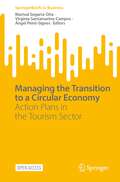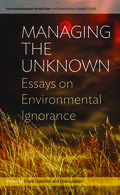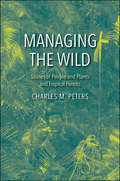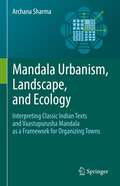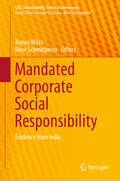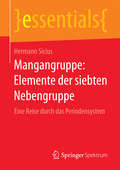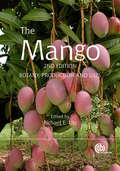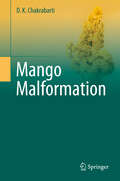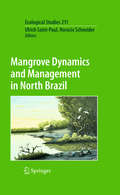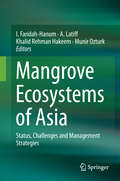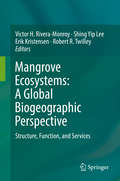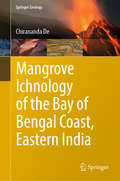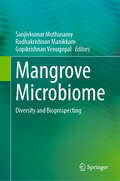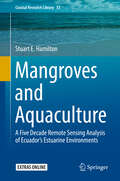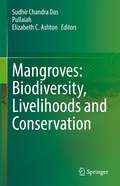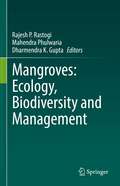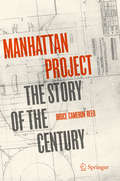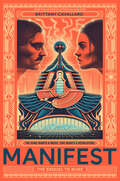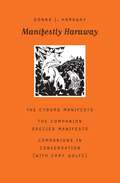- Table View
- List View
Managing the Transition to a Circular Economy: Action Plans in the Tourism Sector (SpringerBriefs in Business)
by Virginia Santamarina-Campos Marival Segarra-Oña Ángel Peiró-SignesThis open access book presents an interdisciplinary analysis of the current status of the circular economy in the tourism sector. This book is presented from the perspective of researchers, policymakers, and industry. Specially aimed at companies in the tourism sector, the book offers valuable information in the field of circular economy, promoting the design/redesign of processes and products. The authors emphasize promoting the development and application of new knowledge and technologies to promote innovation in processes, products, services, and business models, promoting public-private collaboration. With contributions from experts representing varied interests throughout the tourism industry, the book encourages the involvement of economic and social agents to raise awareness of current environmental, economic, and technological challenges.
Managing the Unknown: Essays on Environmental Ignorance
by Frank Uekötter Uwe LübkenInformation is crucial when it comes to the management of resources. But what if knowledge is incomplete, or biased, or otherwise deficient? How did people define patterns of proper use in the absence of cognitive certainty? Discussing this challenge for a diverse set of resources from fish to rubber, these essays show that deficient knowledge is a far more pervasive challenge in resource history than conventional readings suggest. Furthermore, environmental ignorance does not inevitably shrink with the march of scientific progress: these essays suggest more of a dialectical relationship between knowledge and ignorance that has different shapes and trajectories. With its combination of empirical case studies and theoretical reflection, the essays make a significant contribution to the interdisciplinary debate on the production and resilience of ignorance. At the same time, this volume combines insights from different continents as well as the seas in between and thus sketches outlines of an emerging global resource history.
Managing the Wild: Stories of People and Plants and Tropical Forests
by Charles M. PetersDrawn from ecologist Charles M. Peters’s thirty†‘five years of fieldwork around the globe, these absorbing stories argue that the best solutions for sustainably managing tropical forests come from the people who live in them. As Peters says, “Local people know a lot about managing tropical forests, and they are much better at it than we are.” With the aim of showing policy makers, conservation advocates, and others the potential benefits of giving communities a more prominent conservation role, Peters offers readers fascinating backstories of positive forest interactions. He provides examples such as the Kenyah Dayak people of Indonesia, who manage subsistence orchards and are perhaps the world’s most gifted foresters, and communities in Mexico that sustainably harvest agave for mescal and demonstrate a near†‘heroic commitment to good practices. No forest is pristine, and Peters’s work shows that communities have been doing skillful, subtle forest management throughout the tropics for several hundred years.
Mandala Urbanism, Landscape, and Ecology: Interpreting classic Indian texts and Vaastupurusha mandala as a framework for organizing towns
by Archana SharmaClassic Indian texts and Vaastupurusha Mandala are not often discussed in the western discourse on urbanism, even while much of these predate the commonly taught European writings. This book sheds light on some of those forgotten concepts, thus making the lesser discussed classic Indian town organization ideas accessible to architecture, landscape, and urban planning students worldwide. The resonance of these concepts in present times are reviewed through case studies of select Hindu temple towns in India. Furthermore, the author underscores the formal abstraction of the classic Indian Mandala and transplants the discourse from sociology to socio-ecologically adept trans-disciplinary design thinking. The creative interpretations offer a premise to start revising classic models for current practice to influence the urbanism and ecology of a place in accordance with the changing climate.
Mandated Corporate Social Responsibility: Evidence from India (CSR, Sustainability, Ethics & Governance)
by René Schmidpeter Nayan MitraThis book examines the Indian mandate for Corporate Social Responsibility (CSR) and its implementations in various individual organizations. Although the mandate is applicable only to certain large and stable companies, many believe that India is poised to become the birthplace of social, economic and environmental transformation, given the immense size of the Indian population and its challenging socio-economic index. The book explores the various facets of CSR investigation and places special emphasis on the Schedule VII of the Indian Companies Act of 2013, which defines specific areas of intervention for these companies. In addition, it provides a wealth of first-hand case studies that exemplify the ongoing developments and the fundamental challenges and opportunities of mandated CSR.
Manfish: A Story of Jacques Cousteau
by Jennifer Berne Eric PuybaretBefore Jacques Cousteau became an internationally known oceanographer and champion of the seas, he was a curious little boy. In this lovely biography, poetic text and gorgeous paintings combine to create a portrait of Jacques Cousteau that is as magical as it is inspiring. <p><p> <i>Advisory: Bookshare has learned that this book offers only partial accessibility. We have kept it in the collection because it is useful for some of our members. Benetech is actively working on projects to improve accessibility issues such as these in the future.</i>
Mangangruppe: Eine Reise durch das Periodensystem (essentials)
by Hermann SiciusHermann Sicius stellt ausf#65533;hrlich die Elemente der siebten Nebengruppe (Mangangruppe) vor. Er zeigt, dass die Elemente dieser Gruppe, mit Ausnahme des Mangans, chemisch meist relativ reaktionstr#65533;ge sind und regelm#65533;#65533;ige Abstufungen ihrer Eigenschaften zeigen. So nehmen vom Mangan zum Rhenium Dichte, Schmelz- und Siedepunkte zu, die Reaktivit#65533;t jedoch ab. Mangan findet sich als Bestandteil sehr harter St#65533;hle, Technetium wird als Radiotherapeutikum eingesetzt, Braunstein wird in Batterien ben#65533;tigt, Kaliumpermanganat als Desinfektionsmittel und Rhenium als Bestandteil erm#65533;dungsfreier Legierungen f#65533;r Turbinenschaufeln eingesetzt. Technetium war das erste Element, das nur auf k#65533;nstlichem Wege erstmals dargestellt werden konnte, Rhenium ist eines der seltensten Elemente in der Erdh#65533;lle und nur Mangan kommt mit einem Anteil von 850 ppm noch relativ verbreitet vor. Bohrium wiederum, das schwerste Element der Gruppe, ist ebenfalls nur durch k#65533;nstliche Prozesse (Kernfusion) zug#65533;nglich. p>
Mangangruppe: Eine Reise durch das Periodensystem (essentials)
by Hermann SiciusHermann Sicius stellt ausführlich die Elemente der siebten Nebengruppe (Mangangruppe) vor. Er zeigt, dass die Elemente dieser Gruppe, mit Ausnahme des Mangans, chemisch meist relativ reaktionsträge sind und regelmäßige Abstufungen ihrer Eigenschaften zeigen. So nehmen vom Mangan zum Rhenium Dichte, Schmelz- und Siedepunkte zu, die Reaktivität jedoch ab. Mangan findet sich als Bestandteil sehr harter Stähle, Technetium wird als Radiotherapeutikum eingesetzt, Braunstein wird in Batterien benötigt, Kaliumpermanganat als Desinfektionsmittel und Rhenium als Bestandteil ermüdungsfreier Legierungen für Turbinenschaufeln eingesetzt. Technetium war das erste Element, das nur auf künstlichem Wege erstmals dargestellt werden konnte, Rhenium ist eines der seltensten Elemente in der Erdhülle und nur Mangan kommt mit einem Anteil von 850 ppm noch relativ verbreitet vor. Bohrium wiederum, das schwerste Element der Gruppe, ist ebenfalls nur durch künstliche Prozesse (Kernfusion) zugänglich.
Mango
by Richard LitzThe Mango is one of the oldest cultivated fruit crops, having been grown in India for at least 4000 years. Mango is the most important fruit crop of Asia and its annual production is exceeded worldwide only by Musa, citrus, grapes and apples. The last decade has seen a rapid growth of mango production, mainly due to expansion into new growing regions but also to the adoption of modern field practices and cultivars. A wide range of fresh, mango cultivars are now consumed worldwide and are available year round. The Mango: Botany, Production and Uses, published in 1997, represented the first comprehensive examination of all aspects of modern mango production and research. Developing upon the successful first edition, this book incorporates a discussion of significant advances in mango research that have contributed to improved production and will be highly relevant for researchers and growers alike.
Mango Malformation
by D. K. ChakrabartiMalformation disease of mango (Mangifera indica) initially noted in patches in India has now turned into a global menace wherever mango is grown. The challenge posed by the problem attracted interest of Scientists from various disciplines, continue to do so, and will attract their attention until the problem is understood threadbare, and resolved. For a long time, due to complex nature of the disease, the cause and causal agent was both hotly debated. Only in recent years, the issue of the etiology of the disease has been resolved, epidemiology has been worked out to a large extent and silver bullet control measures have been replaced by IPM strategy based on the information generated on the physiology of pathogenesis and epidemiology of the disease.
Mangrove Carbon Trading in the Lower Gangetic Delta: Drawbacks and the Potential
by Abhijit Mitra Sufia Zaman Prosenjit Pramanick Sana AhmedTrue mangrove flora and their associates in the lower Gangetic region are noted for their wide spectrum of ecosystem services in which carbon storage and sequestration by the forest is one of the most important components. Many researchers are updating the carbon repository of the lower Gangetic delta mangroves with the aim to ascertain their role to reduce the carbon dioxide level of the near surface atmosphere. However, due to difficulty in assessment, marketing, and lack of clarity over ownership of natural resources, the mangrove-based carbon trading system has not yet crystallized.There is an estimated 13.76 Mha of mangrove forests world-wide, approximately 20% (2.6 Mha) of which is potentially investible for carbon finance projects, based on the probability of imminent threat. The magnitude and the variability of threats to which the mangroves of the lower Gangetic delta are exposed to have made the trading process more complicated. In addition, gaps also exist between the national government policy and the trading of the blue carbon projects, which has kept the future of such projects remain on hold. The authors put forward the views that the creation of more financial facilities for restoration and expansion of blue carbon (preferably mangroves) with the involvement of the local communities can provide the initial capital involved in developing mangrove-based carbon projects. This includes the costs of conducting feasibility studies, implementing capacity-building programs, monitoring the health of the mangrove plantation/restoration on regular basis, and creating mangrove-based alternative livelihood programs that will support island dwellers of the region in order to accelerate the magnitude of mangrove-based carbon projects leading to growth of the mangrove trading market.
Mangrove Dynamics and Management in North Brazil
by Horacio Schneider Ulrich Saint-PaulMangrove ecosystems are being increasingly threatened by human activities. Their biotic productivity supplies food and other resources to the human populations that inhabit or make use of them. This volume highlights the results of a ten-year German / Brazilian research project, called MADAM, in one of the largest continuous mangrove areas of the world, located in northern Brazil. Based on the analysis of the ecosystem dynamics, management strategies for the conservation and sustainable use of mangroves are presented and discussed. Beyond the scientific results, this book also provides guidelines for the development of international cooperation projects.
Mangrove Ecosystems of Asia
by Khalid Rehman Hakeem Munir Ozturk I. Faridah-Hanum A. LatiffThe book provides an up-to-date account of mangrove forests from Asia, together with restoration techniques, and the management requirements of these ecosystems to ensure their sustainability and conservation. All aspects of mangroves and their conservation are critically re-examined. The book is divided into three sections presenting the distribution and status of mangrove ecosystems in Asia, the challenges they are facing, their issues and opportunities, and the management strategies for their conservation.
Mangrove Ecosystems: A Global Biogeographic Perspective
by Victor H. Rivera-Monroy Shing Yip Lee Erik Kristensen Robert R. TwilleyThis book presents a comprehensive overview and analysis of mangrove ecological processes, structure, and function at the local, biogeographic, and global scales and how these properties interact to provide key ecosystem services to society. The analysis is based on an international collaborative effort that focuses on regions and countries holding the largest mangrove resources and encompasses the major biogeographic and socio-economic settings of mangrove distribution. Given the economic and ecological importance of mangrove wetlands at the global scale, the chapters aim to integrate ecological and socio-economic perspectives on mangrove function and management using a system-level hierarchical analysis framework. The book explores the nexus between mangrove ecology and the capacity for ecosystem services, with an emphasis on thresholds, multiple stressors, and local conditions that determine this capacity. The interdisciplinary approach and illustrative study cases included in the book will provide valuable resources in data, information, and knowledge about the current status of one of the most productive coastal ecosystem in the world.
Mangrove Forests in India: Exploring Ecosystem Services
by Abhijit MitraThis is the first comprehensive science-based primer to highlight the unique ecosystem services provided by mangrove forests, and discuss how these services preserve the livelihoods of coastal populations. The book presents three decades of real-time data on Sundarbans and Bhitarkanika mangroves in India measuring carbon and nitrogen sequestration, as well as case studies that demonstrate the utility provided by mangroves for reducing the impact of storms and erosion, providing nutrient retention for complex habitats, and housing a vast reservoir of plant, animal and microbial biodiversity. Also addressed is the function of mangroves as natural ecosystems of cultural convergence, offering the resources and products necessary for thriving coastal communities. The book will be of interest to students, academics and researchers in the fields of oceanography, marine biology, botany, climate science, ecology and environmental geography, as well as consultants and policy makers working in coastal zone management and coastal biodiversity conservation.
Mangrove Ichnology of the Bay of Bengal Coast, Eastern India (Springer Geology)
by Chirananda DeThis book focuses on the world’s largest mangrove delta complex, located at Sundarban, a world heritage site, and on the relatively new and rapidly expanding scientific discipline of ichnology. In addition to presenting a range of ichnological research databases that are widely applicable to multidisciplinary research fields in geology, biophysics, biology, ecology, geomorphology and the marine and environmental sciences, it addresses the global concern of rising sea levels to explain growing ecological problems, from the mass mortality of coastal organisms and rapid loss of mangrove forest wealth, to widespread coastal and riverbank erosion. It also demonstrates the value of applying new ichnological tools to coastal geotechnical planning and programming, and to groundwater exploration. Thus, the book addresses a broad readership including earth scientists from various disciplines, state administrators and members of the general public.
Mangrove Microbiome: Diversity and Bioprospecting
by Radhakrishnan Manikkam Sanjivkumar Muthusamy Gopikrishnan VenugopalThis book highlights the diversity, and industrial and bio-therapeutic applications of mangrove associated microbiomes. The bioactive metabolites from the mangrove microbiomes show high antimicrobial, antioxidant, anti-inflammatory, anticancer, antidiabetic and anti-biofilm activities. Their environmentally significant capabilities such as remediation, degradation and agriculture enhancing properties are discussed in this book as well. Mangroves are extremely nutrient-rich and productive ecosystems found adjacent to coastal waters and they stand at the base of an extensive food web. Diverse groups of metabolically active microbial populations of this ecosystem produce economically important bio-active metabolites which have environmental, cosmetic, food and biomedical industrial applications. This book aims to consolidate the research, bridge the knowledge gaps, and stimulate further research on mangrove microbiomes. It provides a valuable resource that benefits the scientific community, academic researchers, healthcare practitioners, and individuals interested in the potential use of microbial populations of mangrove ecosystem in managing bio-efficiencies.
Mangroves and Aquaculture: A Five Decade Remote Sensing Analysis of Ecuador’s Estuarine Environments (Coastal Research Library #33)
by Stuart E. HamiltonThis book uses five decades of map data, air photos, and medium to high-resolution satellite imagery to track the expansions of aquaculture and the loss of both estuarine and mangrove land covers in Ecuador. The results are staggering. In some regions, Ecuador has lost almost 50% of its estuarine space and approximately 80% of its mangrove forest. The current estuarine land cover bears no resemblance to the historic estuarine land cover. The analysis is complete from 1968 to 2014. The analysis covers all the major estuaries of mainland Ecuador. The research expands beyond purely land cover into the land use of the estuaries and the implications of the land cover transitions. The author lived in Ecuador's estuarine environments for almost two years studying this area. During this time he conducted mapping workshops with local residents, conducted 100 interviews with local actors, conducted six group discussions with fisherfolk syndicates, conducted eight presentations, worked on a shrimp farm. He was employed by the Ministry of the Environment on a Prometeo fellowship for one-year researching estuarine health and worked on mangrove replanting projects in the estuaries. In addition to the remote sensing data, the author provides a contextual framework to the analysis. It is not just hard numbers that are presented, but a remote sensing analysis tied to local actors that tell a coherent almost 50 -year estuarine story at the national, provincial, and local scales The book is intended for researchers, academics, graduate students, NGOs, and government actors including those who work in development, environment, and policy implementation. It is suitable supplemental reading for students in courses related to the coastal zone, land use change, and remote sensing. The electronically supplementary material includes all the related data to underpin the analysis as well as all the resulting GIS files.
Mangroves in a Changing World: Adaptation and Resilience (Wetlands: Ecology, Conservation and Management #13)
by Vidya Padmakumar Murugan ShanthakumarMangroves are among the most productive and diverse ecosystems on Earth, providing a range of ecosystem services that benefit millions of people and support global sustainability goals. However, mangroves are also highly vulnerable to climate change impacts, such as sea level rise, storms, salinity changes, and erosion, which threaten their survival and functionality. This book aims to provide researchers with the latest scientific knowledge and practical tools to understand, assess, and enhance the adaptation and resilience of mangroves to climate change. It covers topics such as mangrove ecology and distribution, mangrove ecosystem services and valuation, mangrove adaptation and resilience mechanisms and indicators, mangrove restoration and conservation strategies, mangrove governance and policy frameworks, and mangrove modelling and mapping approaches. The book also showcases case studies from different regions of the world, highlighting the challenges and opportunities of mangrove management in a changing world. The book is intended to serve as a valuable reference and resource for researchers, students, practitioners, policymakers, and anyone interested in mangrove science and management.
Mangroves: Biodiversity, Livelihoods and Conservation
by Sudhir Chandra Das Pullaiah Thammineni Elizabeth C. AshtonThis contributory volume is a comprehensive collection on the mangrove forest eco-system and its ecology, the resources and potentials of mangroves, conservation efforts, mangrove eco-system services and threats to conservation. The book is an all-inclusive compilation on the status, conservation and future of mangroves. Mangroves are a unique ecosystem providing several ecosystem services. They are formed in the inter-tidal areas of large rivers and coastal islands. Mangroves thrives due to constant interaction with the terrestrial and marine ecosystem. These are the species dynamics, varying tidal amplitudes, plant succession, changing floral pattern of the channels of the estuary, the varying sediment transportation. There was 20% decline in mangrove forest area in the last 25 years due mainly to conversion and coastal development. Lengthy recovery periods required for the degraded mangrove forests. Hence there is an urgent need to take stock of the updated information on these mangroves at global level. It is of immense value to scientific community involved in teaching, research and extension activities related to mangrove conservation.
Mangroves: Ecology, Biodiversity and Management
by Dharmendra K. Gupta Rajesh P. Rastogi Mahendra PhulwariaMangroves are one of the most productive and biologically important blue-carbon ecosystems across the coastal intertidal zone of earth. In the current scenario of serious environmental changes like global warming, climate change, extreme natural disasters, mangrove forests play a vital role in mitigating greenhouse gas emissions and maintaining ecosystem balance. Mangroves are unique ecosystems with rich biological diversity of different taxonomic groups exhibiting great ecological and commercial importance. The book consolidates existing and emerging information on ecology of mangroves, with a special reference to their biodiversity and management. It emphasizes on the role of mangroves in providing various ecological services. The book is a comprehensive compilation covering all aspects of mangrove ecology. It is useful for students and researchers in ecology, plants sciences and environmental sciences.
Manhattan Project: The Story of the Century (Iop Concise Physics Ser.)
by Bruce Cameron ReedThough thousands of articles and books have been published on various aspects of the Manhattan Project, this book is the first comprehensive single-volume history prepared by a specialist for curious readers without a scientific background. This project, the United States Army’s program to develop and deploy atomic weapons in World War II, was a pivotal event in human history. The author presents a wide-ranging survey that not only tells the story of how the project was organized and carried out, but also introduces the leading personalities involved and features simplified but accurate descriptions of the underlying science and the engineering challenges. The technical points are illustrated by reader-friendly graphics. .
Manhunters: Criminal Profilers and Their Search for the World?s Most Wanted Serial Killers
by Colin WilsonAuthor Colin Wilson opens this illuminating psychological discussion with the development of the 1977 Behavioral Science Unit, which was set up in order to answer the many questions surrounding serial killers: How does someone become a serial killer? How do they choose their victims, and why do they not feel remorse? How are they caught? Wilson interviews FBI Special Agent Robert Ressler, coiner of the term "serial killer" and one of the pioneers of criminal profiling, as well as Ted Bundy and Charles Manson in order to figure out the motives behind their grisly actions.In Manhunters, by tracking the BSU's development of psychological profiling and genetic fingerprinting, Wilson reveals the forensic investigations that caused the seizure and arrest of some of the most vile and villainous people in the world, including Jeffrey Dahmer, William Heirens, Peter Sutcliffe, John Duffy, Jerry Brudos, Wayne Williams, and many more. As he divulges the details of each case, the murderers' fantasy worlds, sadistic motives, and monstrous psychological tendencies emerge.
Manifest
by Brittany CavallaroNew York Times bestselling author Brittany Cavallaro delivers the thrilling conclusion to her YA duology set in a reimagined American monarchy about a girl fighting for her own freedom, trying to change the government from within . . . or burn it all down.For the first time in her life, Claire Emerson isn’t under a man’s control. She’s escaped from her dangerous father, and her fiancé, Governor Remy Duchamp, is too weak to rule. All eyes fall on Claire—and the power she could wield.But that power is precarious as she and Remy are leading St. Cloud in exile after the General’s attempted coup. And when King Washington descends on the small province, he brings with him his baseball team, Claire’s brother, and a proximity to power Claire has never dreamed of. With few allies to support her, she determines her best chance at survival is earning the King’s good graces. Claire’s schemes quickly get out of hand, reminding her that it isn’t about who holds the power. It’s about a system that grants such power to a select few, and the men who built it that way. Claire isn’t anyone’s muse, and if she can’t fix the system from within, she’s determined to be the spark of revolution in the First American Kingdom.
Manifestly Haraway (Posthumanities #37)
by Donna J. HarawayElectrifying, provocative, and controversial when first published thirty years ago, Donna Haraway&’s &“Cyborg Manifesto&” is even more relevant today, when the divisions that she so eloquently challenges—of human and machine but also of gender, class, race, ethnicity, sexuality, and location—are increasingly complex. The subsequent &“Companion Species Manifesto,&” which further questions the human–nonhuman disjunction, is no less urgently needed in our time of environmental crisis and profound polarization.Manifestly Haraway brings together these momentous manifestos to expose the continuity and ramifying force of Haraway&’s thought, whose significance emerges with engaging immediacy in a sustained conversation between the author and her long-term friend and colleague Cary Wolfe. Reading cyborgs and companion species through and with each other, Haraway and Wolfe join in a wide-ranging exchange on the history and meaning of the manifestos in the context of biopolitics, feminism, Marxism, human–nonhuman relationships, making kin, literary tropes, material semiotics, the negative way of knowing, secular Catholicism, and more.The conversation ends by revealing the early stages of Haraway&’s &“Chthulucene Manifesto,&” in tension with the teleologies of the doleful Anthropocene and the exterminationist Capitalocene. Deeply dedicated to a diverse and robust earthly flourishing, Manifestly Haraway promises to reignite needed discussion in and out of the academy about biologies, technologies, histories, and still possible futures.
